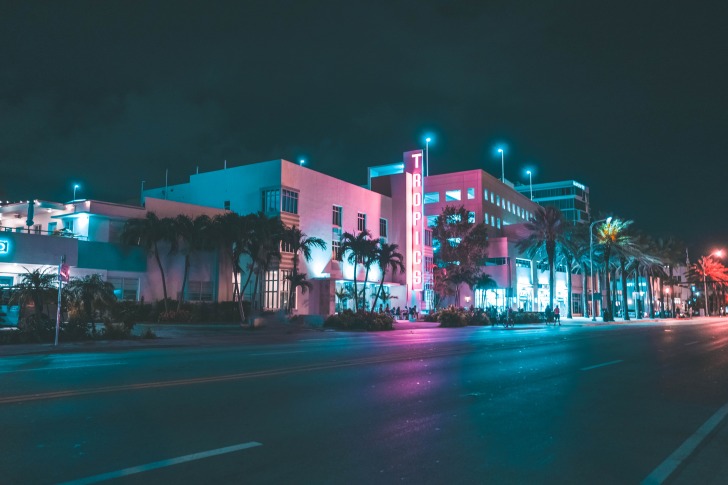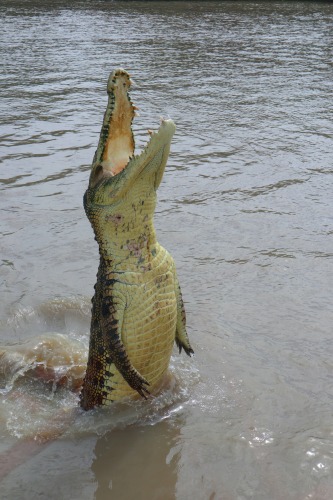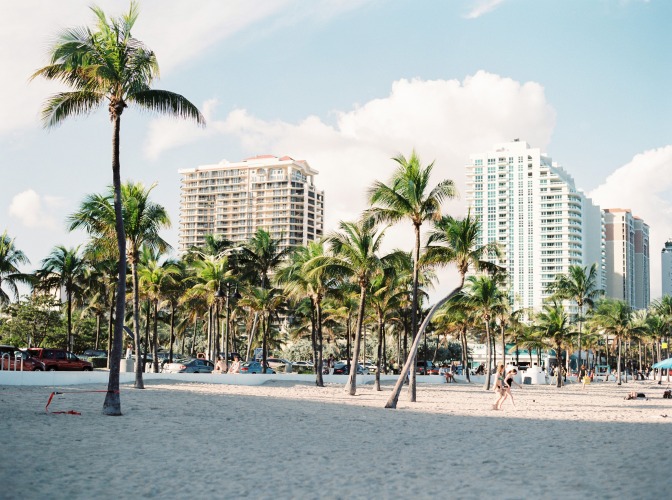Miami, incorporated as a city in July 1896 by Julia Tuttle, William and Mary Brickell, and Henry Flagler, lies in a former mangrove swamp drained by a system of canals.
The entire area lies in the drainage basin of the Kissimmee River and Lake Okeechobee.
Excess rainfall causes overflow from the lake to flow into Florida Bay in a slow-moving sheet.
As a result, the area had and still has dry and wet seasons.
As the water evaporates, it forms the pools and marshes that support the alligators and other animals of the Florida Everglades ecosystem.
Once nearly extinct in the 1950s, the alligator population has swung back.
Thanks to being added to the Endangered Species List in 1967, alligators made it back off the endangered species list in 1987.
Over one million alligators live throughout the entire state of Florida.
Any body of water in Florida, whether natural or artificial, could have an alligator, including swimming pools, ornamental ponds, canals, swamps, rivers, and streams.

Contents
- So, Are There Alligators in Miami?
- Alligator Species in Miami
- Interesting Miami Alligator Facts
- Alligators vs. Crocodiles vs. Caiman
- Is it Safe to Swim in Miami?
- Six Safety Tips for Swiming in Alligator-Infested Waters
- Summary
- Miami Safety Overview
- Frequently Asked Questions
- When did alligators make it off the endangered species list?
- If an alligator gets my dog or cat, should I try to save it?
- Should you climb onto a table or car to get away?
- What should you do when you see an alligator?
- What determines whether an alligator is male or female?
- Which are more aggressive, males or females?
- How many people die every year in Miami from alligator attacks?
So, Are There Alligators in Miami?
Answering that question requires defining Miami’s boundaries and describing the landscape conditions necessary to support an alligator population.
Still, the default answer is, “Even if you don’t see them, they live here,” and “If you do see alligators, there are more nearby that you don’t see.”
Where Is Miami?
The city lies in a floodplain between the Everglades and Biscayne Bay.
Part of the water flowing from Lake Okeechobee through the Everglades empties into the Bay and the Atlantic Ocean.
However, some of the water continues southwest to the Gulf of Mexico.
Conditions in the area created an ideal situation for alligators, who needed temperatures in the 80s and 90s to breed successfully.
Most of the city lies within Biscayne Bay, three to fifteen feet above sea level.
The Gulf Stream keeps the area warm all year, and alligators and other oversize reptiles such as crocodiles and caiman thrive here.
Currently, Miami extends north from Shorecrest at NE 87 Street, south to SW 71st ST, and west to the tip of the Flagami neighborhood, where it touches the Palmetto Expressway.
Consequently, you might see an alligator sunning itself along a canal or beside a golf course pond in Miami.
Alligator Species in Miami
Only two species of alligator inhabit the globe: the American alligator, Alligator mississippiensis, and the Chinese alligator, Alligator sinensis.
However, only the American alligator, Alligator mississippiensis, lives naturally in the United States.
But several other large reptile species also live in Florida, including crocodiles, caimans, Monitor lizards, and iguanas.
You might mistake them for juvenile or adult alligators if you haven’t seen them before.
American alligators average 13 feet long and weigh about 800 pounds.
However, the longest, heaviest alligator recorded by Everglades Park officials measured almost as long as three men lying head-to-toe: a whopping 17 feet, 5 inches.
Under normal circumstances, alligators eat fish, turtles, snakes, and small mammals.
However, because they are opportunists, an alligator will eat carcasses, small and medium-sized pets, and unwary humans.
They tend to avoid human encounters in the wild, but the practice of feeding alligators has made them unafraid.
Thus, alligators congregate in the water under a pier, for example, in hopes that careless anglers will dump bait or unwanted fish parts.
The mangrove swamps of Miami still exist, despite being undercut by the network of canals designed to drain groundwater away from the central business district.
As a result, alligators lurk among the tangled roots and sun themselves on the banks of canals, rivers, streams, and ponds.
In addition, golf courses provide a safe sunning spot next to ponds and fountains, leading to many sightings of these sometimes enormous reptiles.
If you see an alligator sunning, stay at least 25 to 50 feet away, and do not swim there.
Contrary to popular belief, an alligator moves swiftly, sometimes as fast as 30 miles per hour, but only in short bursts, according to the Center for Surf Research.
Usually, they only run 9 to 11 miles per hour, which is still faster than the average human can run.
Interesting Miami Alligator Facts
- Wildlife expert Gator Bill Robb says don’t run zig zag. Alligators’ eyes are on each side of their heads. Run in a straight line instead, so the alligator has to turn its head to see you.
- Stay at least 25 to 50 feet away from alligators. They can run between 9 and 30 miles per hour, while an average human runs 8 miles per hour.
- Only five reported alligator attacks in the Miami area since 2010 have resulted in the victim’s death.
- You have a greater chance of being killed by a car collision with a deer than by an alligator. So watch the sides of the road and always assume more deer will cross the road when you see one.
- The alligator death roll is not a myth. Once they get you in the water, alligators will clamp down and start rolling until you stop struggling and drown.

Alligators vs. Crocodiles vs. Caiman
Alligators and crocodiles mix freely in Florida.
You can distinguish alligators from crocodiles by the bony ridge between their eyes and their long, broad, U-shaped snout with no teeth showing.
In contrast, crocodiles have a much narrower v-shaped nose, and you can see several teeth on each side of the jaws even when shut.
Unlike alligators, 13 species of crocodile exist.
The smallest, the dwarf crocodile (Osteolaemus tetraspis), grows to about 5 feet, 6 inches long, and weighs 13 to 15 pounds.
The gigantic saltwater crocodile (Crocodylus porosus) reaches 23 feet long and weighs up to a ton.
Other Large Reptiles: Caiman
Caiman, also spelled cayman, thrives in the Everglades in the same conditions that favor crocodiles and alligators.
Thus, you will see them together from time to time.
A caiman usually grows between 4 and 7 feet long on average, but the largest species of caiman is Melanosuchus niger, which can grow to 15 feet.
The cayman’s v-shaped snout resembles a crocodile’s but is shorter from the tip to the eye ridge.
Other Large Reptiles: Monitor Lizards
Monitor lizards do not usually live in Miami unless someone has kept them as a pet and released them, or they escaped from a zoo or reptile rescue.
However, the Nile monitor (Varanus niloticus) has known breeding populations in Lee and Palm Beach counties, north of Miami.
Varanus niloticus has occasionally been sighted in Miami but has not yet established breeding populations.
Another species, Varanus Salvator, began lurking near a swimming pool in Davie, Florida, 24 miles north of Miami.
Is it Safe to Swim in Miami?
According to commercial photographer and lifelong Miamian Roldan Torres-Moure, most dangers, such as jellyfish stings, shark attacks, algae blooms, and riptides, happen more rarely than people think.
For example, while you could encounter an alligator in any freshwater pond, pool, or canal, other hazards, including falling coconuts, occur more often.
Statistics on alligator attacks date back to 1948.
Six Safety Tips for Swiming in Alligator-Infested Waters
- When in doubt, don’t. If you think alligators might lurk nearby, go swimming somewhere else.
- Never enter any pool, pond, or stream in the dark. An alligator could lurk anywhere, especially under piers or near mangrove roots.
- Don’t drink and swim anywhere alligators might be. Alcohol reduces your situational awareness, judgment, and impulsiveness. You could get injured or killed when you pull stunts with alligators while drunk.
- Do not approach any alligator. The more human contact alligators receive, the less they fear humans. This lack of fear of humans is especially true with alligators near fishing sites or living on alligator farms.
- If you see a sign posted about alligators nesting or living nearby, don’t swim there and don’t allow pets to walk or explore there.
- If an alligator gets your pet, do not go into the water after it.
Summary
Alligators have had great success since their near-extinction in the 1950s.
They spent 20 years on the endangered species list between 1967 and 1987.
Unfortunately, those protections caused many alligators to lose their fear of human encounters.
Instead, they now regard humans as a food source, thanks to anglers feeding them fish remains and tourists trying to take selfies or purposely swimming with them.
But alligators do not preferentially seek human flesh. Instead, hatchling alligators eat insects, amphibians, and small fish, while older alligators eat large fish, snakes, turtles, small mammals, and shore birds.
If you see signs warning about alligators near any body of water, whether large or small, artificial or natural, heed the warnings and do not swim there.
Stick to pools and beaches with lifeguards and never enter any water source in the dark.
Do not swim, canoe, or kayak while drunk.
Do not approach alligators, take photos with them or attempt any stunts.
Report alligator sightings and encounters with other reptiles in Miami to the Florida Fish and Wildlife Conservation Commission, and stay safe.
Enjoy your stay in beautiful Miami, Florida!
Miami Safety Overview
READ THE FULL REPORT: Miami Safety Review
Safety Index:
- OVERALL RISK: MEDIUM
- TRANSPORT & TAXIS RISK: MEDIUM
- PICKPOCKETS RISK: MEDIUM
- NATURAL DISASTERS RISK: MEDIUM
- MUGGING RISK: MEDIUM
- TERRORISM RISK: MEDIUM
- SCAMS RISK: MEDIUM
- WOMEN TRAVELERS RISK: LOW
Frequently Asked Questions
When did alligators make it off the endangered species list?
Alligators were on the list until 1987.
If an alligator gets my dog or cat, should I try to save it?
First, do not ever go into the water with an alligator.
Although you might manage to protect your pet, the alligator could bite or grab you and begin a death roll underwater, drowning you.
Even if you get away, you could have a severe bite or suffer lingering effects from oxygen deprivation.
Should you climb onto a table or car to get away?
No, alligators can and will climb over obstacles.
So get as far away as possible from the alligator and contact the Florida Fish and Wildlife Conservation Commission online or call the Wildlife Alert hotline at 888-404-FWCC (888-404-3922).
What should you do when you see an alligator?
First, make yourself as tall and large as possible, and run away in a straight line if the alligator does not back away.
What determines whether an alligator is male or female?
Alligators hatched in temperatures above 93 degrees between the second and third week after laying will all become male.
At the same time, you will see all females if the eggs experience temperatures below 86 degrees between day seven and day ten.
Which are more aggressive, males or females?
It depends.
Mating season, which begins in early April, makes males territorial.
Females, however, guard their nests and young, so they attack to protect their hatchlings.
Alligators build a mound of grasses and debris, so stay away from any pile of weeds or other materials near any body of water, large or small.
How many people die every year in Miami from alligator attacks?
There have been five alligator-related deaths in the Miami area since 2010.
Nevertheless, despite the low number of alligator-related deaths, you should avoid them with excessive caution rather than taking a chance at attacks.












It is important to be cautious when swimming in Miami due to the presence of alligators and other large reptiles.
Yes, there are alligators in Miami and they add to the unique charm of our city.